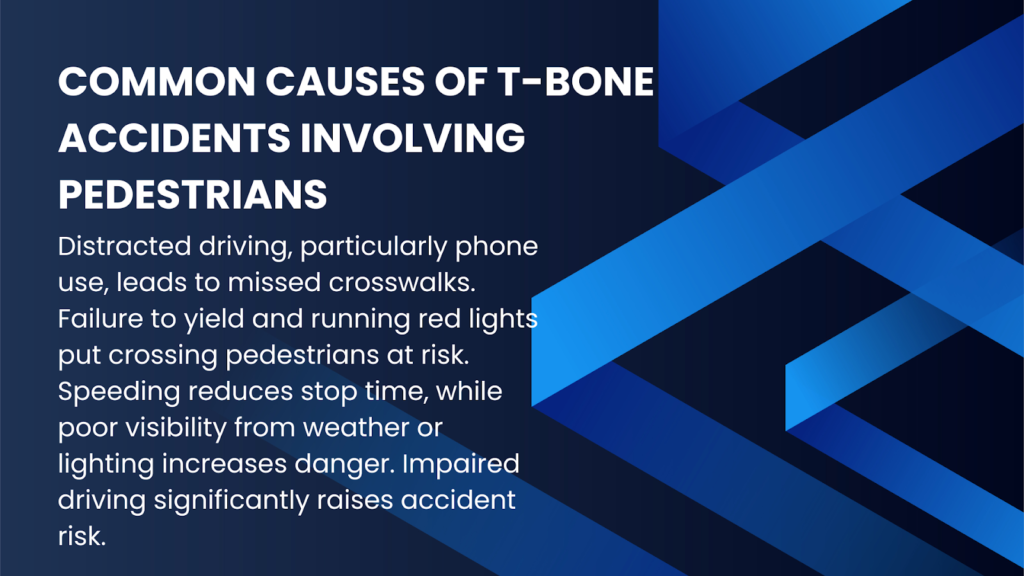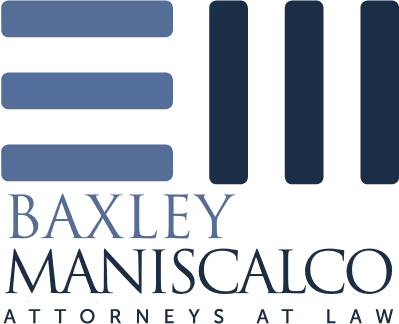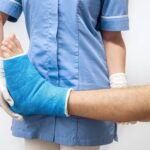
In 2022, Alabama ranked 18th in the nation for pedestrian fatalities per capita. This sobering statistic underscores the dangers faced by pedestrians on our roads, especially when it comes to T-bone accidents.
These side-impact collisions can be particularly devastating for those on foot, often resulting in severe injuries and complex legal battles.
Here, our Alabama pedestrian accident attorneys will walk you through what you need to know to stay prepared for and act properly in a T-bone accident involving pedestrians.
Understanding T-Bone Accidents and Pedestrian Involvement
T-bone accidents, also known as side-impact collisions, occur when the front of one vehicle crashes into the side of another, forming a “T” shape.
While we often think of these accidents involving two vehicles, pedestrians can also fall victim to such collisions, with potentially catastrophic consequences.
In Alabama, the bustling streets of cities like Birmingham, Montgomery, and Mobile are hotspots for these types of accidents. The combination of distracted drivers, complex intersections, and a high volume of foot traffic creates a perfect storm for T-bone accidents involving pedestrians.
Common Causes of T-Bone Accidents Involving Pedestrians
Understanding the root causes of these accidents is crucial for both prevention and determining liability.
Here are some of the most frequent factors contributing to T-bone accidents that injure pedestrians:
- Distracted driving: Drivers focused on their phones or other distractions may fail to notice pedestrians in crosswalks or at intersections.
- Failure to yield: Motorists who don’t give right-of-way to pedestrians, especially at marked crossings, put pedestrians at risk of side-impact collisions.
- Running red lights or stop signs: This dangerous behavior can result in vehicles striking pedestrians who are lawfully crossing the street.
- Speeding: Excessive speed reduces a driver’s ability to stop in time when a pedestrian enters the roadway.
- Poor visibility: Inadequate street lighting or inclement weather can make it difficult for drivers to see pedestrians, increasing the risk of T-bone accidents.
- Impaired driving: Alcohol or drug use significantly impairs a driver’s judgment and reaction time, putting pedestrians at greater risk.
By addressing these common causes, we can work towards reducing the frequency of T-bone accidents involving pedestrians in Alabama.

Typical Injuries Sustained by Pedestrians in T-Bone Accidents
The human body is no match for the force of a moving vehicle, especially in a side-impact collision. Pedestrians involved in T-bone accidents often suffer severe, life-altering injuries.
Some of the most common include:
- Traumatic brain injuries (TBIs): The impact of a vehicle can cause the head to strike the ground or the vehicle itself, resulting in concussions or more severe brain damage.
- Spinal cord injuries: The force of a T-bone collision can cause vertebral fractures or damage to the spinal cord, potentially leading to paralysis.
- Broken bones: Fractures are common in these accidents, particularly in the legs, hips, and arms, which are most vulnerable to side impacts.
- Internal injuries: The force of impact can cause damage to internal organs, leading to internal bleeding and other life-threatening conditions.
- Soft tissue injuries: Sprains, strains, and tears to muscles, ligaments, and tendons are frequent in pedestrian accidents.
- Psychological trauma: The emotional impact of a T-bone accident can be just as devastating as the physical injuries, often resulting in PTSD, anxiety, or depression.
These injuries can have long-lasting effects on a pedestrian’s quality of life, ability to work, and financial stability. Understanding the potential severity of these injuries is crucial when considering legal action and seeking appropriate compensation.
Determining Liability in Pedestrian T-Bone Accidents
Establishing liability in T-bone accidents involving pedestrians can be complex, as multiple factors come into play.
In Alabama, the concept of “contributory negligence” can significantly impact a pedestrian’s ability to recover damages. Here’s what you need to know:
- Driver liability: In most cases, the driver who failed to yield right-of-way or violated traffic laws will be held primarily responsible for the accident.
- Pedestrian responsibility: Pedestrians have a duty to follow traffic signals and use designated crosswalks. Jaywalking or disregarding traffic signals could affect liability.
- Contributory negligence: Alabama follows a strict contributory negligence rule, which means if a pedestrian is found to be even 1% at fault for the accident, they may be barred from recovering any damages.
- Multiple parties: In some cases, liability may extend beyond the driver to include vehicle manufacturers (if a defect contributed to the accident) or government entities responsible for road maintenance and design.
- Evidence collection: Determining liability often relies on evidence such as witness statements, surveillance footage, and accident reconstruction reports.
- Police reports: The responding officer’s assessment of the accident scene can play a crucial role in establishing liability.
Given the complexities of Alabama’s contributory negligence law, it’s essential for injured pedestrians to seek legal counsel to protect their rights and navigate the intricacies of liability determination.
Legal Options for Injured Pedestrians in Alabama
If you’ve been injured as a pedestrian in a T-bone accident in Alabama, you have several legal options to pursue compensation for your injuries and losses:
- Insurance claims: Filing a claim with the at-fault driver’s insurance company is often the first step in seeking compensation.
- Personal injury lawsuit: If insurance negotiations fail to provide adequate compensation, you may need to file a lawsuit against the responsible parties.
- Wrongful death claim: In tragic cases where a pedestrian loses their life in a T-bone accident, their family may pursue a wrongful death claim.
- Uninsured/underinsured motorist claims: If the at-fault driver lacks insurance or has insufficient coverage, you may be able to claim under your own policy if you have this coverage.
- Product liability claims: In cases where vehicle defects contributed to the accident or severity of injuries, you may have a claim against the manufacturer.
- Government entity claims: If poor road design or maintenance played a role in the accident, you might have a claim against the responsible government agency.
It’s important to note that Alabama has a two-year statute of limitations for personal injury claims, so timely action is crucial to preserve your legal rights.
Steps to Take After a Pedestrian T-Bone Accident
If you’ve been involved in a T-bone accident as a pedestrian, taking the right steps immediately after the incident can significantly impact your ability to recover damages.
Here’s what you should do:
- Seek medical attention: Your health is the top priority. Even if you feel fine, some injuries may not be immediately apparent.
- Call the police: An official accident report is crucial for your case.
- Gather evidence: If possible, take photos of the accident scene, your injuries, and collect contact information from witnesses.
- Do not admit fault: Be careful what you say at the scene, as statements can be used against you later.
- Document everything: Keep records of all medical treatments, expenses, and how the injuries impact your daily life.
- Contact an attorney: Given Alabama’s strict contributory negligence laws, it’s crucial to have legal representation to protect your rights.
- Notify your insurance company: Report the accident to your insurance provider, but be cautious about giving recorded statements without legal counsel.
- Follow medical advice: Adhering to your treatment plan demonstrates the seriousness of your injuries and commitment to recovery.
By following these steps, you’ll be better positioned to pursue a successful claim for your injuries and losses.
Frequently Asked Questions
Navigating the aftermath of a T-bone accident as a pedestrian can be overwhelming.
Here are answers to some of the most common questions we receive from our clients.
What If I Was Partially at Fault for the T-Bone Accident?
Alabama’s contributory negligence law means that if you’re found even slightly at fault, you may be barred from recovering damages. It’s crucial to consult with an attorney who can help protect your rights and build a strong case on your behalf.
How Long Do I Have to File a Lawsuit After a Pedestrian T-Bone Accident in Alabama?
Alabama has a two-year statute of limitations for personal injury claims. This means you generally have two years from the date of the accident to file a lawsuit. However, it’s best to start the process as soon as possible to ensure evidence is preserved and witnesses’ memories are fresh.
What Types of Compensation Can I Recover in a Pedestrian T-Bone Accident Case?
Potential compensation may include medical expenses, lost wages, pain and suffering, emotional distress, and loss of enjoyment of life. In severe cases involving permanent disability, you may also be entitled to compensation for future medical care and loss of earning capacity.
Can I Still Recover Damages If the Driver Who Hit Me Was Uninsured?
If you have uninsured motorist coverage on your own auto insurance policy, you may be able to file a claim under that coverage. Additionally, there may be other parties who share liability, such as the vehicle manufacturer or a government entity responsible for road maintenance.
How Can I Prove the Driver Was at Fault for the T-Bone Accident?
Evidence such as police reports, witness statements, surveillance footage, and accident reconstruction reports can help establish fault. An experienced attorney can help gather and present this evidence effectively to support your claim.
Protect Your Rights After a Pedestrian T-Bone Accident
Have you or a loved one been injured in a T-bone accident as a pedestrian? Don’t let Alabama’s complex legal system stand in the way of your recovery. At Baxley Maniscalco, our experienced team of personal injury attorneys is dedicated to fighting for the rights of pedestrian accident victims.
We understand the devastating impact these accidents can have on your life, and we’re here to help you navigate the legal process with compassion and expertise. From dealing with insurance companies to building a strong case for compensation, we’ll be by your side every step of the way.
Don’t wait until it’s too late to seek the justice and compensation you deserve. Contact Baxley Maniscalco today for a free, no-obligation consultation.
Let us use our knowledge and experience so you can focus on what matters most—your recovery.
Can't find what you're looking for? Search our site below.










